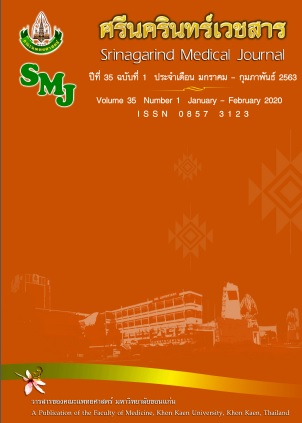Results of Screening Colonoscopy in Kasetwisai Hospital
Keywords:
คัดกรองมะเร็งลำไส้ใหญ่, Screening ColonoscopyAbstract
ผลการตรวจคัดกรองมะเร็งลำไส้ใหญ่โดยวิธีส่องกล้องในโรงพยาบาลเกษตรวิสัย
บุญรื่น ไชยชาญรมย์
กลุ่มงานบริการทางการแพทย์ โรงพยาบาลเกษตรวิสัย
หลักการและวัตถุประสงค์: มะเร็งลำไส้ใหญ่ เป็นมะเร็งที่พบมากที่สุดในระบบทางเดินอาหาร พบมากเป็นอันดับสามของมะเร็งในเพศชายและอันดับสี่ของมะเร็งในเพศหญิง ถ้ารวมประชากรทั้งหมดเป็นมะเร็งที่พบมากเป็นอันดับห้า โดยส่วนใหญ่จะมาเมื่อมีอาการแล้วซึ่งบางครั้งสายเกินไป ดังนั้น ในการที่จะวินิจฉัยได้เร็วหรือตั้งแต่เป็นติ่งเนื้ออยู่ จะสามารถลดอัตราการตายและอุบัติการณ์การเกิดมะเร็งลำไส้ใหญ่ได้อย่างชัดเจน วิธีที่ดีที่สุดคือเลือกบุคคลที่มีความเสี่ยงมาทำการตรวจคัดกรองโดยการส่องกล้องลำไส้ใหญ่เพื่อให้เจอมะเร็งระยะเริ่มต้น
วิธีการศึกษา: ประชาชนที่มีความเสี่ยงคือ อายุ 50-70 ปี ถูกสุ่มคัดเลือกให้มาทำ FIT-test พบคนที่ผล FIT- test เป็นบวก และไม่มีข้อห้ามในการส่องกล้องลำไส้ใหญ่จำนวน 822 ราย ได้รับการตรวจคัดกรองมะเร็งลำไส้ใหญ่โดยวิธีส่องกล้องลำไส้ใหญ่ในโรงพยาบาลเกษตรวิสัย ตั้งแต่เดือนธันวาคม พ.ศ. 2560 – มกราคม พ.ศ.2562
ผลการศึกษา: ตรวจพบมะเร็งลำไส้ใหญ่ระยะที่สอง 11 ราย ( ร้อยละ 2.09) ซึ่งได้รับการรักษาและผ่าตัดตามแนวทางมาตรฐาน พบ Adenomatous polyp และ Tubulovillous adenoma 169 ราย (ร้อยละ 21.16) ทั้งหมดได้รับการทำ Polypectomy ในขณะส่องกล้องพบ ในจำนวน 169 ราย พบ Polyp ที่มีขนาดมากกว่าหรือเท่ากับ 1 เซนติเมตร(มีความเสี่ยงปานกลางถึงสูงที่จะกลายไปเป็นมะเร็งลำไส้) จำนวน 45 ราย (ร้อยละ 4.43) พบ Diverticulums 61 ราย (ร้อยละ 8.06) Colitis/Proctitis 30 ราย (ร้อยละ4.42) พบพยาธิในลำไส้ 12 ราย (ร้อยละ1.16) และ ริดสีดวงทวารหนัก 3 ราย (ร้อยละ0.7) มีภาวะแทรกซ้อนใหญ่คือลำไส้ใหญ่ทะลุ 2 ราย (ร้อยละ0.24) ซึ่งได้รับการแก้ไขทันที
สรุป: ขณะนี้เป็นที่ยอมรับว่าส่วนใหญ่แล้วมะเร็งลำไส้ใหญ่เปลี่ยนแปลงมาจาก Adenomatous polyp ซึ่งเรียกเหตุการณ์นี้ว่า adenoma – carcinoma sequence ถ้าขนาดเพิ่มขึ้นโอกาสเปลี่ยนแปลงไปเป็นมะเร็งลำไส้ใหญ่จะสูงขึ้นโดยเพิ่มขึ้นร้อยละ 35-50 ใน polyp ที่มีขนาดมากกว่า 2 เซนติเมตร ดังนั้นจากการตรวจคัดกรองมะเร็งลำไส้ใหญ่ในการศึกษานี้สามารถขจัดโอกาสการเปลี่ยนแปลงไปเป็นมะเร็งลำไส้ใหญ่ของ Neoplastic polyps ถึง 169 ราย (ร้อยละ21.16 ของประชาการที่มีความเสี่ยง 822 ราย)
Background and Objective: Colorectal carcinoma is the most common malignancy of the gastrointestinal tract. It is the third common cancer in men, the fourth common cancer in women, and the fifth common cancer for both sex in the world1. When patients come to the hospital with gastrointestinal symptoms ,frequently it is too late. Early detection along with improvements in medical and surgical care are thought to be responsible for the decreasing mortality of colorectal cancer observed in recent year. The best way to find early cancer of colon , potential people were selected for screening colonoscopy2.
Materials and methods: The potential people(50-70 years old and positive Fit-test)and no contraindication for colonoscopy 822 cases were selected and performed screening colonoscopy from December 2017 – January 2019 in Kasetwisai Hospital.
Results: There were well differentiated adenocarcinoma in 11 cases ( 2.09 %) and all were stage II by TNM Staging whom received medical and surgical care. Adenomatous polyp and tubulovillous adenoma were found in 169 cases ( 21.16 % ) were diagnosed and performed polypectomy.In this group there were intermediate and high risk polyps (large polyp/tubulovillous adenoma) 45 cases (4.43% ) . Others were diverticulums 61 cases (8.06%) ,colitis/proctitis 30 cases (4.42%) , parasitic infestation 12 cases (1.16%) and hemorrhoids 3 cases (0.7%) . The complication was colonic perforation in 2 cases (0.24%).
Conclusion: It is now well accepted that the majority of colorectal carcinoma was evolved from adenomatous polyp; the sequence of events is adenoma – carcinoma sequence.The incidence of invasive carcinomas increase with size (35-50% in polyp larger than 2 cm )3. This study could eliminated colorectal cancer strategies by targeting the neoplastic polyps for removal before malignancy develops in 169 cases (21.16 % of all the potential people 822 cases).
References
Khuhaprema T. Srivatanakul P. Cancer in Thailand . Thai Can J 2010; 5: 2001-3.
Lieberman DA, Weiss DG, Bond JH, Ahnen DJ, Garewal H, Chejfec G. Use of colonoscopy to screen asymptomatic adults for colorectal cancer. N Engl J Med 2000; 343: 162-8.
Kelli M, Bullard Dunn. Colon, Rectum, and Anus. In: Charles B, editor. Schwartz’s Principle of Surgery. Ninth Edition. New York: McGraw-Hill Books, 2010:1041-6.
Somchai J. The sensitivity and Specificity of Guaiac-fecal occult blood test (G-FOBT) and Fecal Immunochemical Test (FIT) for colorectal screening. J Med Tech Assoc Thailand 2013; 41: 4590-7.
Pignone, Rich M, Teutsch SM. Berg AO, Lohr KN. Screening for colorectal cancer in adults at average risk: a summary of the evidence for the U.S. Preventive Services Task Force. Ann Intern Med 2002;137: 132-41.
Smith RA1, von Eschenbach AC, Wender R, Levin B, Byers T, Rothenberger D, et al. American Cancer Society guidelines for the early detection of cancer: update of early detection guidelines for prostate, colorectal, and endometrial cancers. Also: update 2001--testing for early lung cancer detection. CA Cancer J Clin 2001; 51: 38-75.


